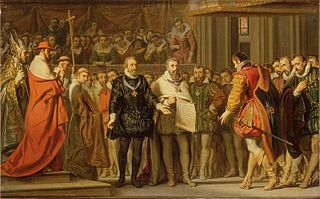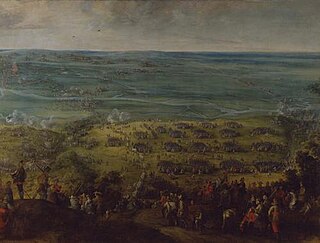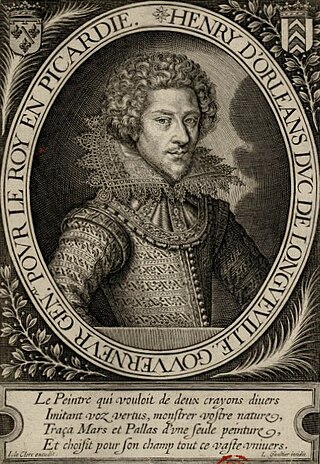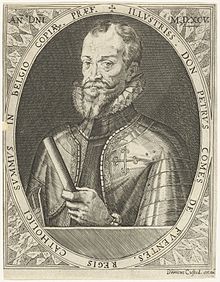
The French Wars of Religion were a series of civil wars between French Catholics and Protestants from 1562 to 1598. Between two and four million people died from violence, famine or disease directly caused by the conflict, and it severely damaged the power of the French monarchy. One of its most notorious episodes was the St. Bartholomew's Day massacre in 1572. The fighting ended with a compromise in 1598, when Henry of Navarre, who had converted to Catholicism in 1593, was proclaimed King Henry IV of France and issued the Edict of Nantes, which granted substantial rights and freedoms to the Huguenots. However, Catholics continued to disapprove of Protestants and of Henry, and his assassination in 1610 triggered a fresh round of Huguenot rebellions in the 1620s.

The Battle of Denain was fought on 24 July 1712 as part of the War of the Spanish Succession. It resulted in a French victory, under Marshal Villars, against Dutch and Austrian forces, under Prince Eugene of Savoy.

The Peace of Vervins or Treaty of Vervins was signed between the representatives of Henry IV of France and Philip II of Spain under the auspices of the papal legates of Clement VIII, on 2 May 1598 at the small town of Vervins in Picardy, northern France, close to the territory of the Habsburg Netherlands.

The Anglo-Spanish War (1585–1604) was an intermittent conflict between the Habsburg Kingdom of Spain and the Kingdom of England that was never formally declared. It began with England's military expedition in 1585 to what was then the Spanish Netherlands under the command of Robert Dudley, Earl of Leicester, in support of the Dutch rebellion against Spanish Habsburg rule.

Henri de La Tour d'Auvergne was a member of the powerful House of La Tour d'Auvergne, the Prince of Sedan and a marshal of France. He was a prominent Huguenot figure.

Pedro Henriquez d'Azevedo y Alvarez de Toledo, Count of Fuentes de Valdepero was a Spanish general and statesman.

Doullens is a commune in the Somme department, Hauts-de-France, France.

The Battle of Honnecourt took place on 26 May 1642, during the 1635 to 1659 Franco-Spanish War. A Spanish army led by Francisco de Melo defeated and largely destroyed a French force under the Comte de Guiche.

The Battle of Fontaine-Française occurred on 5 June 1595 between the French royal forces of King Henry IV of France and troops of Spain and the Catholic League commanded by Juan Fernández de Velasco and Charles of Lorraine, Duke of Mayenne, during the eighth and final war (1585–1598) of the French Wars of Religion.

The Battle of Arques occurred on 15–29 September 1589 between the French royal forces of King Henry IV of France and troops of the Catholic League commanded by Charles of Lorraine, Duke of Mayenne, during the eighth and final war (1585–1598) of the French Wars of Religion. It was a victory for Henry IV.

The Crossing of the Somme took place on 5 August 1636 during the Thirty Years' War and the Franco-Spanish War when units of the Spanish Army of Flanders and the Imperial Army under Thomas Francis, Prince of Carignano, lieutenant of the Cardinal-Infante Ferdinand of Austria, crossed the Somme river near Bray-sur-Somme during its offensive in French territory. Despite the fierce resistance of the French army led by Louis de Bourbon, Count of Soissons, the allied troops successfully crossed the river and drove off the French troops along the Oise river, proceeding over the following weeks to invest the important fortress of Corbie, located two leagues upriver of Amiens, which caused a spread of panic among the population of Paris.

Henry I of Orléans-Longueville was a French aristocrat, military leader and Grand Chamberlain of France between 1589 and 1595.

The siege of Amiens was a siege and battle fought during the Franco-Spanish War (1595–1598), as part of both the French Wars of Religion and the Anglo-Spanish War (1585–1604), between 13 May and 25 September 1597. The Spanish, who had sent a large army in March, had captured the city of Amiens easily in a ruse. Henry IV of France, after the surprise of the capture, immediately and quickly built up an army which included a large English force and besieged Amiens on 13 May.

The siege of Calais of 1596, also known as the Spanish conquest of Calais, took place at the strategic port-city of Calais, between 8 and 24 April 1596, as part of the Franco-Spanish War (1595–1598), in the context of the French Wars of Religion, the Anglo-Spanish War (1585–1604), and the Eighty Years' War. The siege ended when the city fell into Spanish hands after a short and intense siege by the Spanish Army of Flanders commanded by Archduke Albert of Austria, Governor-General of the Spanish Netherlands. The French troops in the citadel of Calais resisted for a few days more but finally, on 24 April, the Spanish troops led by Don Luis de Velasco y Velasco, Count of Salazar, assaulted and captured the fortress, achieving a complete victory. The Spanish success was the first action of the campaign of Archduke Albert of 1596.
The siege of Rouen was an unsuccessful attempt by Henry IV of France to capture Rouen, the historical capital city of Normandy. The battle took place as part of the French Wars of Religion, the Eighty Years' War, and the Anglo–Spanish War (1585–1604). Although he had claimed the throne in 1589, Henry, a Huguenot, was not recognized by many of his Catholic subjects. He was forced to fight against a Catholic League determined to resist his rule, and which was aided by Spain.
The siege of Le Catelet, also known as the Capture of Le Catelet, took place at the stronghold of Le Catelet, in Picardy, between 20 and 26 June 1595, as part of the Franco-Spanish War (1595-1598) in the context of the French Wars of Religion. After a short siege, the Spanish forces commanded by the new Governor-General of the Spanish Netherlands, Don Pedro Henríquez de Acevedo, Count of Fuentes (Spanish: Conde de Fuentes), took the French fortress, compelling its garrison to surrender, as part of his offensive of 1595. A few days later the Count of Fuentes and his forces continued with the offensive and took La Capelle. On 14 July they arrived at Doullens and laid siege to the city.

The Battle of the Lippe was a cavalry action fought on 2 September 1595 on the banks of the Lippe river, in Germany, between a corps of Spanish cavalry led by Juan de Córdoba and a corps of Dutch cavalry, supported by English troops, led by Philip of Nassau. The Dutch stadtholder Maurice of Nassau, taking advantage of the fact that the bulk of the Spanish army was busied in operations in France, besieged the town of Groenlo in Gelderland, but the elderly governor of the citadel of Antwerp, Cristóbal de Mondragón, organized a relief army and forced Maurice to lift the siege. Mondragón next moved to Wesel, positioning his troops on the southern bank of the Lippe river to cover Rheinberg from a Dutch attack. Maurice aimed then, relying on his superior army, to entice Mondragón into a pitched battle, planning to use an ambush to draw the Spanish army into a trap. However, the plan was discovered by the Spanish commander, who organized a counter-ambush.

The siege of Huy of 1595, also known as the assault of Huy, took place between 7 and 20 March 1595, at Huy, Archbishopric of Liège, Low Countries, as part of the Eighty Years' War and the Anglo-Spanish War (1585–1604). It concluded in a Spanish victory.
Events from the year 1595 in France
The Luxembourg campaigns were two military campaigns by the Dutch Republic and the Duchy of Bouillon against the Spanish Southern Netherlands during the Eighty Years' War in 1593 and 1595. The first was undertaken by a Dutch States Army commanded by Philip of Nassau to the Duchy of Luxembourg in early 1593, with the aim of distracting the Spanish Army of Flanders to a different part of the Habsburg Netherlands, create confusion and block the importation of new pro-Spanish troops to the Low Countries via the Spanish Road. Other goals were dealing economic damage to Spain, and supporting the Protestant claimant to the French throne Henry of Navarre and the Protestant prince of Sedan and duke of Bouillon, Henry de La Tour d'Auvergne.



















